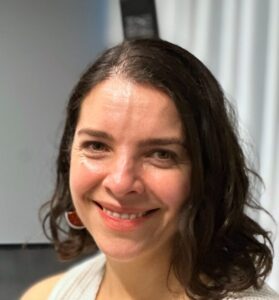The prevalence of myasthenia gravis (MG) doesn’t vary much from one country to another. But where patients live — to a large extent — can determine how quickly they’re diagnosed, what kind of therapies they receive and how well they function in society.
“There’s quite a variability around the world in how people with myasthenia gravis are diagnosed and treated,” said Dr. Carolina Barnett-Tapia, Ph.D., an associate professor of neurology at the University of Toronto. “You can help a patient improve symptoms, but it’s not enough to treat the cause of the disease. We need treatments that not only control the disease, but eventually cure or put it in remission.”

Originally from Chile, Dr. Barnett-Tapia spoke about the difficulties facing patients and doctors across Latin America at the Myasthenia Gravis Foundation of America’s recent 15th International Conference on Myasthenia and Related Disorders in the Netherlands.
Because of the relative scarcity of neurologists across the region, MG patients there can “have a hard time being diagnosed,” Dr. Barnett-Tapia said, so their disease is often more advanced. Complicating matters, many Latin American countries either lack antibody tests or have to send them abroad, which can be costly.
Read more about MG testing and diagnosis
“We know that treating patients earlier, it’s better for the long run. I think the first problem is early diagnosis and early treatment,” she said. “Once patients in Latin America are diagnosed, most will be able to receive prednisone, which is the most common medication to treat myasthenia. It’s very effective, but can also have many side effects.”
She added that other immunosuppressants, such as azathioprine, are fairly available, while pyridostigmine (Mestinon) is “surprisingly expensive” — even though it’s the only MG medication considered essential by the World Health Organization.
‘Tremendous’ gains in MG treatment, but at cost
Dr. Barnett-Tapia’s myasthenia gravis clinic at the University of Toronto follows over 600 patients per year, she said, making it Canada’s leading center for MG treatments as well as clinical trials.
“Novel treatments have made a big difference in our care for people with myasthenia because they work fast, compared to some of our typically oral medications, and they have fewer side effects,” said Dr. Barnett-Tapia, whose mentor was Dr. Vera Bril, one of Canada’s top experts in the disease. “But these treatments are very expensive and not accessible.”
She added: “I don’t think they should be used as the first treatment for all patients because some of the old treatments actually work very well.”
Read more about MG therapies
She sees cell therapy — specifically, chimeric antigen receptor (CAR)-T cell therapy — as a potentially promising treatment for MG, an autoimmune disease.
“This is a therapy initially developed for cancer, but we’re harnessing that to see if we can treat, at the source, the cells that produce the antibodies and see if that gives us a longer, more robust response down the line,” she said, adding that she’s “very optimistic” about the future of MG treatment.
“When I started training years ago, the only thing we had was prednisone, nonsteroidal immunosuppressants, Mestinon, and some rescue treatments. Now we have so many options,” Dr. Barnett-Tapia said. “I have seen patients for whom these novel treatments have made a big, big difference, and who can tell you that they did not remember feeling this well for years. That is tremendous.”
Such advances in treatment also can help with patients’ quality of life, others at the conference noted. MG overwhelmingly affects women, including younger adults.
The disease “has a major impact on family planning,” said Dr. Amelia Evoli, an associate professor of neurology at the Università Cattolica del Sacro Cuore in Milan. A study in Germany of 245 female patients of childbearing age found “more than 50% are avoiding another pregnancy, and more than 20% are postponing pregnancy,” she added.
MG patient with pneumonia inspired work towards new treatment
Dr. Kfir Oved, the founder and CEO of Israel’s Canopy Immuno-Therapeutics, holds a dual Ph.D. in medicine and immunology. In 2009, he cofounded his first company from an idea scrawled on a napkin, with the goal of creating “groundbreaking solutions for antibody-mediated autoimmune diseases” like MG.

“My entrepreneurial journeys were all centered around a specific clinical problem or a specific patient I met,” Dr. Oved said.
One such patient was a 26-year-old woman named Natalie.
“She suffered from myasthenia gravis, but she didn’t come to the hospital because of MG. The real reason she came was a very nasty community-acquired pneumonia,” he said. “It was quite evident to me, even as a med student, that she had acquired the pneumonia because of the drugs we gave her for MG.”
In short, Natalie was getting sicker — not healthier — as a result of the treatment she was receiving.
“With antibody-mediated autoimmune diseases, patients develop antibodies against one of our body’s own constituents. We experience an infection and three, four, five weeks — or even months — later, we develop an autoimmune disease. This is the result of an immune response that actually turns against us.”
The woman recovered with intensive treatment.
“Fortunately, she was only 26 and had a strong body and a lot of physiological reserves. If she had been 25 years older, this might have had a different outcome,” he said. “The bottom line is that by creating immunosuppression, each and every one of these drugs — without any exception — also exposes patients to side effects.”
Pursuing a ‘potentially curative’ MG treatment
Dr. Oved favors antigen-drug conjugates (AgDCs), targeted therapies that are not immunosuppressive. His company, on its website, describes these therapies as a “potentially curative” class of biologics for MG and other antibody-mediated autoimmune diseases.
“With superb specificity, AgDCs eliminate only the pathological antibodies and autoreactive B cells while leaving protective immunity intact,” Canopy, which is working to develop such biologics, states.
The root cause of MG is limited to less than 0.01% of a patient’s entire immune system, Dr. Oved said. That means that 99.99% of the antibodies found in the blood of a person like Natalie — or the B cells that produce them — are normal.
“They’re actually protective. They’re anti-influenza, anti-COVID, anti-Epstein-Barr virus and anti-[cytomegalovirus (CMV)],” he said. “Only a tiny minority of cells that produce these rugged antibodies actually cause the disease.”
Vaccines create antigen-specific immunity by eliciting an immune response. What Dr. Oved hopes to do is the exact opposite: completely abolish the specific immune response that causes MG.
“Imagine we have a tool to eliminate the immune response against the receptor that caused the disease. In Natalie’s case, we could potentially allow her to be completely immuno-competent because we’ve target only that 0.01% of cells and antibodies,” he said. “We could even potentially cure her, because with the lack of antibodies, there is no disease anymore.”
Listen to an interview with Kfir Oved on Rare Disease Advisor, an MG Companion sister site: An Interview With Kfir Oved, CEO of Canopy Biotech, Which Is Pursuing MG Treatments
Sign up here to get the latest news, perspectives, and information about MG sent directly to your inbox. Registration is free and only takes a minute.
